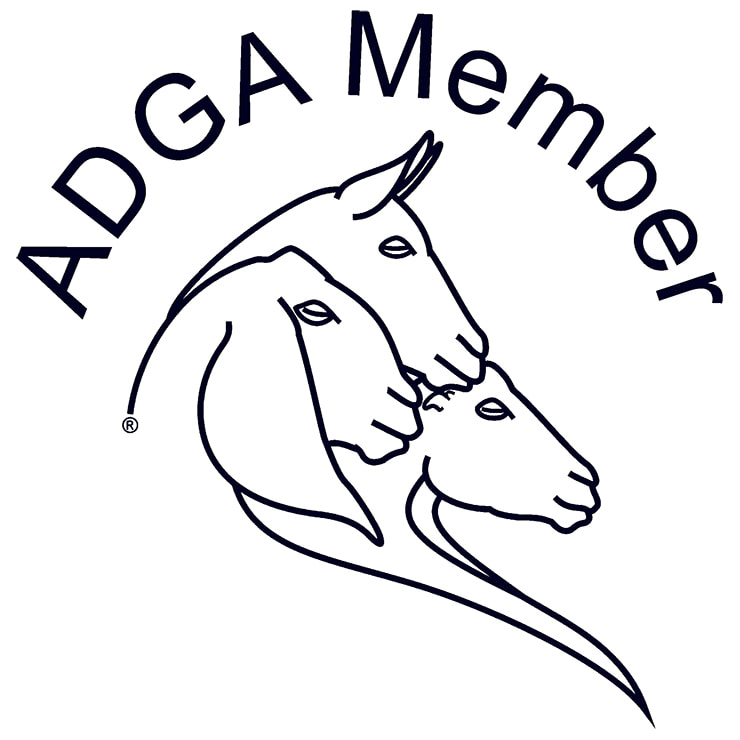First things first. This page is just for informational purposes only. I am not a veterinarian or by no means an expert on goats. I'm not making any recommendations as to how to manage YOUR goats, this is just a brief explanation on how *I* manage *my* herd. Also *my way* may (most likely WILL) change over time.
updated 8-21-23 to reflect new herd goals and farm mission of resilience, parasite resistance, and longevity.
updated 8-21-23 to reflect new herd goals and farm mission of resilience, parasite resistance, and longevity.
|
Daily:
All herd members have free access to fresh, clean water, Mineral Supplement (Conceptaid- 5S), local grass hay, and unlimited browsing within the pasture daily. ** My herd is not pampered or coddled. They receive what is necessary to maintain condition & not a drop more. My goats will never be overweight or live in luxury. It is my express goal to bred goats that are resilient to our area -- high heat & humidity which creates the perfect environment for parasites to thrive. If any goat at my farm requires worming more than once a year or cocci prevention past 16 weeks old, they will be sold unregistered. I will not tolerate unthrifty animals. If they cannot maintain condition with minimal "interference" from humans, they do not belong on my farm. These does may be sold registered with full knowledge of their need for "pampering" (more feed or more frequent attention to their individual needs) to the prospective buyer. I know this sounds callous and unfeeling, quite the contrary.. I love my goats, but will not allow my family to suffer want in order to cater to my herd of goats. ** Supplements, Disbudding, Tattooing, bottle feeding, etcBirth to 3 months
Most Susurrare Salix kids will be dam-raised. I do not feel that it is necessary to bottle raise our kids to prevent CAE infection as our entire herd is CAE tested negative. Goats LOVE their kids, and kids love their dams, therefore I will not routinely remove a kid from it's dam prior to weaning unless the dam rejects the kid, the kid is showing obvious signs of distress, or the kid is nursing their dam unevenly. For basic instructions on bottle feeding, please see BOTTLE BABY CARE days 14-21: ALL non-polled kids on our farm are disbudded. I do the procedure myself with a Rhinehart X30 disbudding iron and spray the site with Alushield to cool and help to keep the site clean for the first week. Bucks are disbudded in a figure 8 pattern to ensure full horn base coverage and to help prevent scurs. All kids receive Vitamin B Complex and pro-bios gel the day of disbudding. On the date of disbudding, all kids will also receive their unique tattoo sequence. For instructions on Tattoo Procedure, please see TATTOOING 8 weeks: Bucks kids are separated from Does. If the buck is destined to be a wether (as the vast majority of our buck kids are), he is banded & is ready to leave the farm. Doe kids are ready to leave the farm at 8weeks old, but will remain with their dam until pickup. Retained doe kids remain with their dam. at 3, 6, 9, & 12 weeks old: Each Kid is preventatively dosed with Valbazen (for worms) and Baycox (for cocci -- we sometimes use 40% Sufadimethoxine solution, but I am allergic to Sulfa, so we use Baycox). They also receive probiotic gel and a shot of b complex (this is to combat the side effects that baycox occasionally has on the gut - if we dose preventatively with b complex & probiotics we have far fewer complications from the harsh Baycox medication). they are also topically treated with Cylence to prevent external parasites. -- note about Baycox: Be very careful where you obtain your baycox prescription. There is a popular horse website that sells a poor quality baycox.. it is not effective, and many breeders are having cocci outbreaks as a result. 3 months and beyond: As neeeded: Hoof Trimming. April - August - Shave the herd down to help with the heat of summer (also to assess conformation & obtain pictures for this website). 1x Annually: The entire herd receives a Copper Bolus with Copasure. May & November: All bucks, wethers, and non-breeding animals are given a Bo-Se booster. Breeding Does: at 4 months gestation: Doe receives a injected dose of Bo-Se & Vitamin A,D&E. New Herd Members: We rarely purchase animals anymore, but when we do, we only purchase animals from CAE & CL free herds. We have a Quarantine Pen for all incoming goats, this enables us to test each new animal and to ensure that each new herd member is completely healthy and adjusted to us and our feeding/milking schedule prior to release into the "General Population".
Quarantine Testing (on animals over 1 year old): Biosecurity Screening through Washington Animal Disease Diagnostic Laboratory (WADDL - this includes cElisa CAE & CL). GrainWe feed all does and doe kids a Dairy Goat Pellet, and all bucks, buck kids, and wethers a goat pellet that contains Ammonium Chloride to prevent Urinary Calculi.
We use AgCentral Co-Operative's Dairy Grain #93446 for our does & #93458 for our bucks & wethers. LA, Showing, and MilkingAs you may have noticed, I generally do not "Set Up" the goats for photos. I feel that candid shots (pasture pics) are far better for really knowing the strengths and weaknesses of each animal.
Showing: I have no plans to join the show circuit now or at any time in the future. Our kids have frequently been sold in to show farms and tend to do well in the ring, but show animals are not my priority or focus. A conformationally correct goat is always the main goal, but the show ring winners vary greatly in conformation and style. Therefore, IMO, breeding for what currently wins in the show ring is an exercise in futility. Instead, I breed my herd for resilience, parasite resistance, and longevity. Milking: At 12 weeks fresh the kids are weaned, and the does begin twice-a-day milking for a total of 5 months. DHI: One Day Milk Test performed on our farm once every year beginning in 2014, which enables our does to obtain ADGA Milking awards and prove milking ability. Also, it's very helpful to know the butterfat and protein components of each doe. **Am assessing the financial feasibility of continued milk test considering ADGA still will not (or cannot) process One Day Milk Competitions and award stars based on the results of One Day Milk Competitions. ADGA's Next Generation Software - NG - was implemented in 2020 - that's 3 years as of data not processed as of the date this was written. 3 years of milk tests which my herd and myself have worked hard to complete, with no processing of stars by ADGA. It is not cheap to feed a doe for production, and will not continue to make this a focus if ADGA cannot live up to its end of the agreement.** What you will receive when you purchase an animal from us.Papers: All animals that are registered or are purchased as registered breeding animals will go home with ALL paperwork. I will not sell an animal that is not able to be registered in your name immediately upon transport. All members of my herd (excepting wethers) are registered with AGDA. In most cases, the Registered Name will agreed upon by both the buyer and myself before transport, and will therefore already be filled out on the paperwork. I am very willing to work with the buyer to name each animal, therefore, if you have a preference for a specific name, please let me know. If the name isn't already taken, is *not* on my short list of names for keeper kids, and is in line with our theme, I am more than willing to allow the buyer to name the animal. If the name is NOT filled out, feel free to pick anything you like.
Other Paperwork: If applicable, and arrangements are made in advance: A Health Certificate from our veterinarian will be provided at the expense of the buyer. Service memo(s) will also be provided at the time of transport for registered does that have been purchased bred or exposed (please see below). Honesty: I will give you the absolute truth about any registered animal I sell, or offer for sale. Be it an uneven udder, a serious personality issue, or an inability to raise kids.. Help. When you purchase a goat or goats from us, I am available to you. Anytime. Day or night, rain or shine, sleet, snow, or 100 degrees. If you have a question, need training in hoof trimming, disbudding, immunizations, or just need to talk goat, give me a yell via text, email, or facebook - whatever works best for you. If I don't know the answer, I'll do everything in my power to find it. Adult Does and Does in Milk: If you purchase a doe in milk, please be aware that production will likely decrease due to transport and the stress associated with leaving her herdmates and joining a new herd. Also, personality shifts are not uncommon when a doe is moved to a new herd. I have purchased does that were "problem animals" in a previous herd (screamers, milkstand jumpers, does that "Hate Humans" turn into absolute darlings here... and vice versa). Keep in mind these are living animals with attachments to their herdmates, or no attachments in some cases. An unhappy doe in my farm may be extremely happy in a larger or smaller herd. Frequently the fact that a doe is clearly unhappy in my farm is a sole reason for selling, and I do my best to find a situation that will benefit both the doe and the buyer. Also of note - my adult does that have freshened at least twice are trained to the milk stand. I use curb chains to train my does not to kick or jump, therefore they are used to, and expect, those chains to be in place while milking. After a few weeks on the stand with these chains in place, they realize nothing bad is happening to them, they accept the process & settle and stop fighting the routine of the milking process. If you purchase a doe in milk and do not choose to use curb chains, or milk from the same position or in the same manner that I do, be prepared for a confused doe. Goats are very happy with a set routine. Even moving the milkstand a few inches one way or another will cause them frustration and annoyance. So, of course , if they move farms they frequently will attempt to fuss about it. This may result in kicking and jumping on the milkstand. Please be kind to the doe, she just needs to learn the new routine. If you ask, I will happily show you the routine that the doe is used to so that you can attempt to recreate it at your farm. Bottle Kids: I will never allow a bottle-fed kid to leave our farm until and unless he or she is completely used to the bottle and will happily suck it right down. I do my very best to feed the kid in a multitude of different fashions (standing up, being held, walking around, etc), but occasionally a kid will be very particular about how it likes to be fed. I do my best to inform the buyer of any particular peculiarities of the manner of bottle feeding that the kid might have. If the bottle kid you have purchased is refusing the bottle, please first check the temperature of the milk (slightly higher than your skin, the bottle should feel warm in your hand), then attempt feeding in different positions (while holding the kid in the left arm and bottle in right hand, or vice versa, kid standing up, etc). If the kid still refuses to eat, please contact me immediately. Transport Stress: Transport Stress to the kid or adult can be very common in goats. They are sensitive animals that can go "off" very quickly. Please remember that they have just been taken away from all their friends and herdmates, placed in a crate & transported via vehicle probably for the first time in their lives. That would be upsetting to me, too. Normally a goat will bounce back fairly quickly without need for medication or help, but occasionally they will have serious side effects from this stress - including, but not limited to: pneumonia (coughing and non-clear mucous discharge from nose), worm and or cocci bloom (manifesting with scours), & refusal to eat or drink. As a matter of routine I give a dose of Biomycin prior to leaving my farm to combat serious issues caused by transport stress. Please give the animal probiotics several times a day for at least a week following transport to help them overcome stress and adapt to their new environment. If scouring or refusing to eat, please contact me immediately. On the date of Transport: The animal will receive a hoof trimming. The transporter and I will visually inspect the animal prior to loading to ensure the animal is in good health. When the animal leaves the farm with a transporter, I will contact you as soon as they depart to let you know they are on their way. Once the animal is loaded for transport, the care and health of the animal are transferred completely to the new owner/transporter. I am not liable for any injury or mistreatment of the animal while in the care of the transporter -- I maintain the right to refuse to allow the animal to be transported up to and including the moment the animal is to be loaded. If this should ever occur, I will contact the buyer immediately to inform them of the reason(s) for my refusal and to offer alternate transport or a full refund of the purchase price. I am always available after the sale for further questions! Please contact me if you need anything or have any questions. For more information, please view our Sales Policy. |




